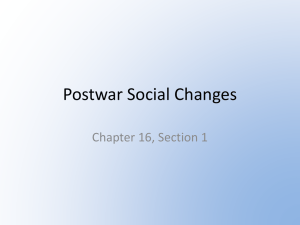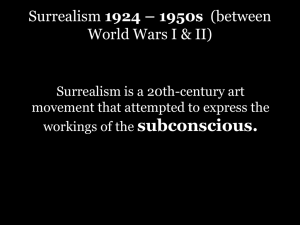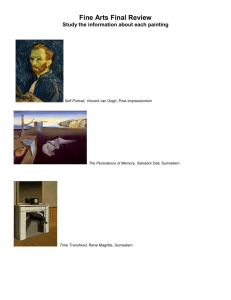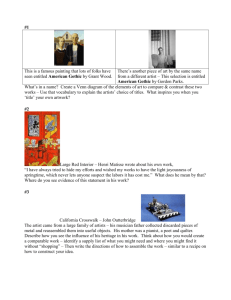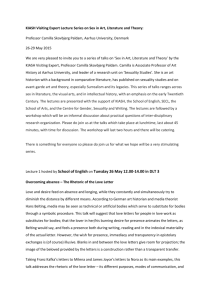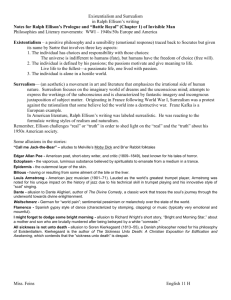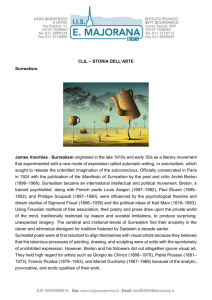Hakoyama 1 Tatsuki Hakoyama Artist Statement Redefining the
advertisement
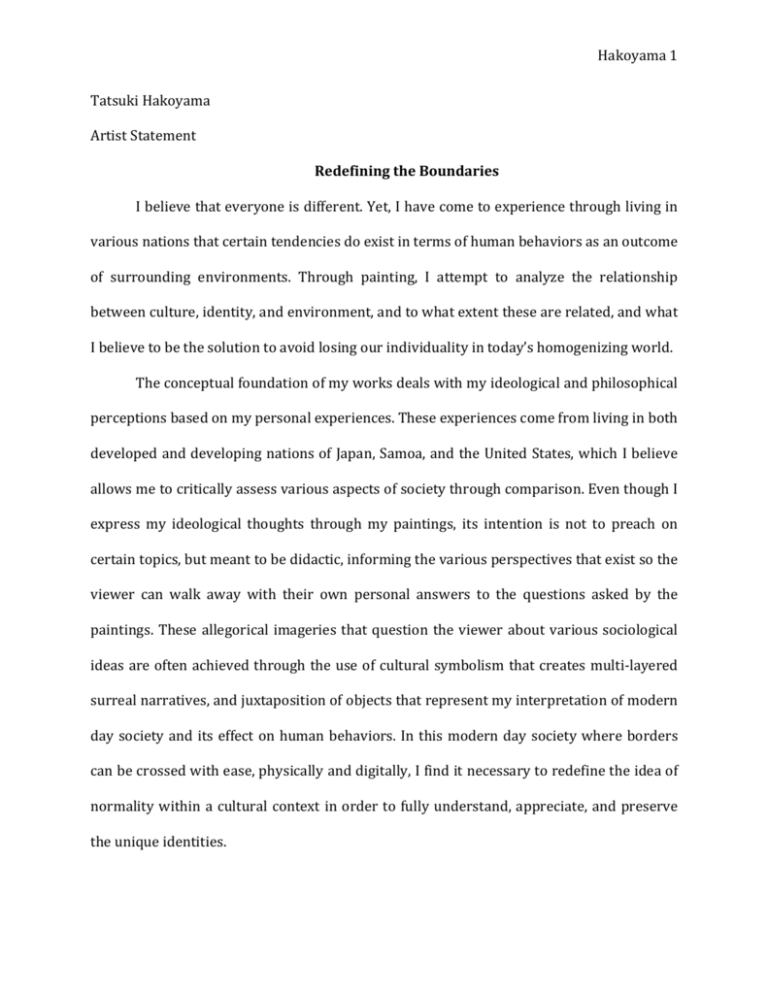
Hakoyama 1 Tatsuki Hakoyama Artist Statement Redefining the Boundaries I believe that everyone is different. Yet, I have come to experience through living in various nations that certain tendencies do exist in terms of human behaviors as an outcome of surrounding environments. Through painting, I attempt to analyze the relationship between culture, identity, and environment, and to what extent these are related, and what I believe to be the solution to avoid losing our individuality in today’s homogenizing world. The conceptual foundation of my works deals with my ideological and philosophical perceptions based on my personal experiences. These experiences come from living in both developed and developing nations of Japan, Samoa, and the United States, which I believe allows me to critically assess various aspects of society through comparison. Even though I express my ideological thoughts through my paintings, its intention is not to preach on certain topics, but meant to be didactic, informing the various perspectives that exist so the viewer can walk away with their own personal answers to the questions asked by the paintings. These allegorical imageries that question the viewer about various sociological ideas are often achieved through the use of cultural symbolism that creates multi-­‐layered surreal narratives, and juxtaposition of objects that represent my interpretation of modern day society and its effect on human behaviors. In this modern day society where borders can be crossed with ease, physically and digitally, I find it necessary to redefine the idea of normality within a cultural context in order to fully understand, appreciate, and preserve the unique identities. Hakoyama 2 If we are indeed affected by our surrounding environment, I believe we – inhabitants of modern day society – must attempt to maintain the ability to question and adapt in order to sustain humanity from indulgence in artificial intelligence, convenience, and materialistic lifestyles controlled by objective interpretation of time. Since my works are the outcome of interpretation based on living in both developed and developing nations, I hope that the paintings not only question various aspects of society, but also provide a different perspective as basis for comparison to fully understand the significance of the topics implied within my paintings. I believe, to understand the origin of my conceptual foundation, it is important to understand the immense differences abundant amongst cultures. During my stay at a Polynesian nation of Samoa, where globalization of technology had not yet greatly affected the culture and lifestyle, I recall having difficulties adjusting to the new environment as an eight-­‐year-­‐old child. The walls that surrounded the vaguely objective concept of norms were torn apart. My original understanding of “houses” being enclosed by walls was discarded when I encountered traditional Samoan fale, where wooden posts are all that support the roof. Samoans who climb trees with a bush knife in their mouth, chopping down coconuts or branches from twenty, thirty yards high without any safety equipment for their routine chores. Who can imagine lines of students swinging bush knives that they brought to school from home as form of lawn care in public school grounds? The culture shocks occur not only as an outcome of differences in the developed/developing nations, but also between the two developed nations in which I have lived. The idea of driving across the United States, which I have observed to be fairly common, will likely be unbelievable for most Japanese, considering even the state of Hakoyama 3 Michigan itself is over half the area of Japan in its entirety. On the other hand, the school policy I had back in my elementary school in Japan, where students walked anywhere from thirty to sixty minutes to school everyday (including the winter), would appear preposterous for many where school buses were provided for the recent decades. To express these cross-­‐cultural comparisons, there are common occurrences in my paintings that I use for sources of symbolism. Origami is often used for portraying various objects – which in themselves often have symbolism – to outline my cultural heritage. An origami crane can be found in When the Caged Bird Sings No More (fig. 1), a painting that questions the extent of cultural immolation as an outcome of globalization and technology, and our approach to the issue. A caged origami crane is held by a miner wearing a suit, juxtaposed to replace a canary in a coalmine, implying the context of sacrifice for the sake of development of the society. In Persistence of Metaphysical Existence (fig. 2), a common wearable origami, kabuto – which is a helmet traditionally worn by Japanese samurai (“Kabuto”) – are used along with nifo ‘oti, a traditional weapon unique to Samoa even among the similar clubs from other Polynesian nations (Oceania), to imply the metaphorical battle in maintaining the values of different cultures from being buried by the new environment and lifestyles Samoan seascapes recur to represent the lifestyles prior to the importation of major technologies, and can be observed in Persistence of Metaphysical Existence, and also in The Invitation (fig. 3). In both of these paintings, the Samoan seascape is juxtaposed through the use of a torii, a gate originating from Shintoism, which separates the divine, pure world from the rest of the world (Mori). By using the symbolism implied with the torii, I express Hakoyama 4 my perception of the spiritual essence that exists within the nature and the lifestyles closely associated with nature. Experiencing the proclaimed righteousness of various communities, I have to state once again that questioning is the key to maintaining identities. Since the youthful days where curiosity was a major part of growing up, to adulthood where our minds are programmed to believe in the absoluteness of ideas, I cannot deny the impact environment has on its inhabitants. I have observed certain tendencies that occur as an outcome of environments, and with subliminal messages and propaganda that surround us today, I believe questioning and contemplation is the key to defending against becoming pawns, so we can attempt to achieve our own utopian solution as an individual. It is important to note that pursuing our own individual ideals does not imply we must have different thoughts. If, as an outcome of contemplation, people have the same ideals, it simply means that they share a similar utopian goal. On the contrary, if one simply states an opposing idea to be different, I find it against the individual identity. It is through questioning, that we can understand our own ideal solutions to social issues that surround us every day. Since the questioning and breaking down of the norm are the main emphasis of my works, it is not a coincidence that I am drawn to surrealism. Founder of surrealism, André Breton, stated in Manifestoes of Surrealism, “surrealism attempted to provoke, from the intellectual and moral point of view, an attack of conscience, of the most general and serious kind” (123). Moreover, Salvador Dalí, one of the most famous surrealists has stated, “surrealism is destructive, but it destroys only what is considered to be shackles limiting our vision” (qtd. in Sandoval). These boundless approaches to the worldview by Hakoyama 5 surrealists inspire my compositions, like Entre les trous de la memoire (fig. 4) by the Swiss painter, Dominique Appia, which creates a never-­‐ending cycle of contemplation as to its content, along with many of René Magritte’s works. Despite the intimate relationship between the conceptual foundations on which surrealism is built and my own works, my specific content, I believe, corresponds more with the magic realists since their artworks often deal with conflicting perspectives, and unlike surrealism, are set in a normal modern world with genuine descriptions of societies and humans (Moore). Like the magic realists, I attempt to incorporate indigenous cultures and contemporary mindset – in both acceptance and rejection – through multifaceted compositions, building the images that fuse the closely related surrealism and magical realism using my own cultural experiences (Rios). With my works showing a strong connection to magic realism, which often incorporates postmodernist philosophies, it is inevitable for my works to be built on certain aspects of the vague, hard-­‐to-­‐define postmodernism. It is, because I realize the immense effect my history and experiences had on my personality, perception, and ideology, that I must acknowledge the validity of individual perspectives in order to maintain legitimacy of my own individuality, and as an outcome, I am forced to recognize the multiplicity of historical perspectives of each person (Bowers). With my personal philosophical logic bound to the aforementioned concept, I am obligated by my own intellect to state my interpretation based on what I have witnessed from living in unique cultures has just as much validity as others who have not experienced different cultures. The previous paragraph seems to overthrow the purpose of my art; yet, I believe the concept of constructive postmodernism – which I find to be similar to post-­‐postmodernism Hakoyama 6 – allows my work to regain its reason for existence. Unlike deconstructive postmodernism, which rejects modernism and implies the incapability for communication, constructive postmodernism revises the premise of modernism to deliver unity amongst scientific, ethical, aesthetic, and religious institutions. Science does benefit humankind. It answers our curiosities and provides knowledge. Constructive postmodernism does not reject science but only the scientific approach in which only the data is allowed to contribute in creating the construction of our views (Witcombe). My goal, through my work, is not to define an objective truth or ideal, but to question the subjectivity, and have the viewer achieve his or her own answers to the proposed questions. As a person with different “homes” that provided me with diverse experiences that have immensely affected my philosophy, I believe we must redefine the boundaries that we create, and question the seemingly apparent ideals in today’s world where cultures can be imported and exported with ease. The “good” and “bad” are only subjective terms and if we wish for mutual understanding amongst different social groups, answers must be obtained. And without questions, answers cannot exist. Let us question. Let us contemplate. Let us redefine the boundaries. Hakoyama 7 Appendix Fig. 1. Tatsuki Hakoyama. When the Caged Bird Sings No More. 2012. Oil on Canvas. 60 x 53 inches. Fig. 2. Tatsuki Hakoyama. Persistence of Metaphysical Existence. 2012. Oil on Panel. 33 x 24 inches. Hakoyama 8 Fig. 3. Tatsuki Hakoyama. The Invitation. 2011. Oil on Panel. 24 x 72 inches. Fig. 4. Dominique Appia. Entre les trous de la Memoire. Hakoyama 9 Works Cited Appia, Dominique. "Entre les Trous de la Memoire." __DOMINIQUE APPIA__. N.p., n.d. Web. 10 Oct. 2012. <http://www.appia-­‐d.ch/index2.htm>. Bowers, Maggie Ann. Magic(al) Realism. New York: Routledge, 2004. Print. Breton, Andre. Manifestoes of Surrealism. Ann Arbor: University of Michigan Press, 1969. Print. "Kabuto." Webster's Online Dictionary. Webster's Online Dictionary. Web. 8 Oct. 2012. <http://www.websters-­‐dictionary-­‐online.net/definitions/Kabuto>. Moore, Lindsay. "Magical Realism." Emory University, n.d. Web. 7 Oct. 2012. <http://www.english.emory.edu/Bahri/MagicalRealism.html>. Mori, Mizue. "Torii." Encyclopedia of Shinto. Kokugakuin University, 2 June 2005. Web. 8 Oct. 2012.<http://eos.kokugakuin.ac.jp/modules/xwords/entry.php?entryID=280>. Oceania. Pitt Rivers museum, n.d. Web. 8 Oct. 2012. <http://web.prm.ox.ac.uk/weapons/index.php/tour-­‐by-­‐ region/oceania/oceania/arms-­‐and-­‐armour-­‐oceania-­‐201>. Rios, Alberto. "Some Various Definitions of Magical Realism." Magical Realism: Definitions. Arizona State University, 23 May 2002. Web. 8 Oct. 2012. <http://www.public.asu.edu/~aarios/resourcebank/definitions/>. Sandoval, Jose, ed. "Salvador Dali Gallery." Dada and Surrealism. Duke University, 19 Nov. 1998. Web. 3 Oct. 2011. <http://www.duke.edu/web/lit132/dali_art.html>. Witcombe, Christopher. "Modernism and Postmodernism." What is Art? What is an Artist? Sweet Briar College, n.d. Web. 8 Oct. 2012. <http://www.arthistory.sbc.edu/artartists/modpostmod.html>.
